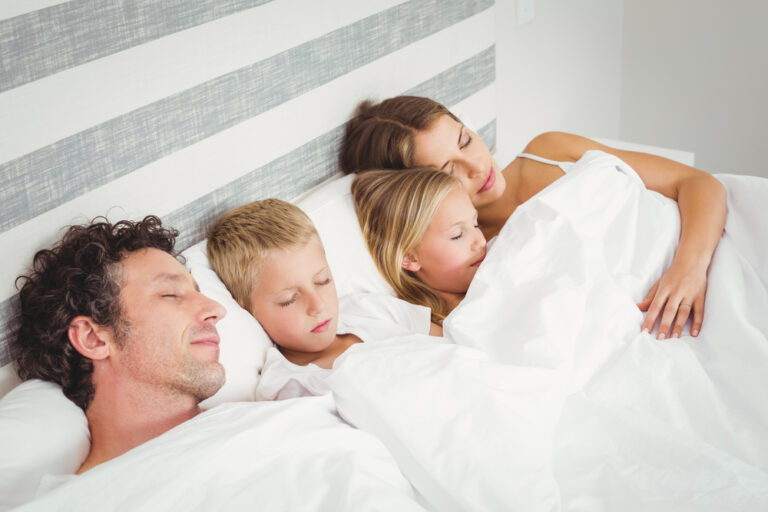We never planned on co-sleeping. It sort of just happened.
When our first child was born, we were so careful for those first few months to keep him in his own bed. Then as time went on, we just got so tired. It started with one nap in bed together after a long nursing session. Then a few days later, he slept in the bed after nursing and stayed there all night.
Long story short, we ended up co-sleeping for the next 2 years. As first-time parents, we didn’t know the exact parenting rules. We just knew what worked and what was easiest for all of us.
It wasn’t until I mentioned to another mom that we co-slept that we realized that it was supposedly wrong.
I’ll admit that it does has its risks – suffocation or other harm.
But co-sleeping is not as terrible as it’s made out to be. It can be a beautiful way to bond and share with your baby, and it’s honestly so much easier for us tired parents.
But don’t take my word for it. Here’s why co-sleeping is actually good for you and baby.
Co-Sleeping Hasn’t Always Been Un-Cool
Let’s take a quick look back at co-sleeping and bed-sharing in the days of old.
Communal sleeping used to be the norm. Families, servants, and even strangers shared rooms and even beds.
Before the mid-19th century, most families – except for the extravagantly rich – shared one sleeping room. Babies would either sleep in the bed with the parents, or they’d have a small cradle near the bed. As they grew, they’d graduate to a bed with a sibling or two.
As houses got bigger, babies got further away. The Victorians finally separated sleeping into separate rooms and separate beds, babies included.
Dr B.W. Richardson wrote in 1880 that no one should have to share a bed, especially adults and children. It would take away their vital warmth and enfeeble them at a vulnerable point in their lives. He also stressed that morning breath was a huge problem with bedmates.
Issues like health, disease, and privacy increasingly kept babies apart from their families. And then, like now, no one wanted to go against the dictated norm.
Co-Sleeping is the Norm Globally
What if I told you that America and Western Europe were the biggest conspirators against co-sleeping? And that’s no surprise, given that these areas have an individualistic approach to life, versus the communal approach of other countries.
So where do babies bed-share and co-sleep without a second thought?
- Southern Europe
- Asia
- Africa
- Central America
- South America
These cultures embrace co-sleeping until the baby is weaned. Sometimes, children even sleep with their parents much longer.
But one country I want to focus on is Japan. They’re industrialized and successful just like America.
But a big difference needs to be noted: the infant mortality rate. While Japan has the second lowest infant mortality rate in the world, at 1.8 deaths for every 1000 births, the US ranks markedly lower, at 5.8 deaths for every 1000 births.
Japanese co-sleeping rates are higher than those in the US by 16% but their infant mortality rate is 68% lower. This means that co-sleeping is unlikely to be the dominant factor in infant mortality.
Japan also has one of the lowest SIDS occurrence rates.
Bed-sharing is a widely-accepted norm there. It has been and stays a part of the culture, with children sleeping with or near parents or grandparents well into the teen years.
This wide acceptance of co-sleeping in other parts of the world means that modern American families need to take a serious look at accepting co-sleeping as normal and beneficial.
Benefits of Co-Sleeping
Let me give you a nice little laundry list of the benefits of co-sleeping.
- Makes breastfeeding easier
- Parents sleep longer without as much interruption
- Babies sleep longer
- Children are more secure going into the toddler years (in short, you can help lessen clingy toddler syndrome)
- Parents can respond naturally to their child’s needs for food and comfort
- Increased physiological response in the baby, like better temperature regulation, higher heart rate, and more stable blood glucose levels.
- Possible positive effect on SIDS incidences (see above)
SIDS and Co-Sleeping
Let’s talk more about SIDS. Especially the reduction in the SIDS rate in co-sleeping nations. Some countries, such as Japan, have reduced SIDS rates when they safely utilize co-sleeping. While this is contrary to what the AAP currently recommends in the US, it lines up correctly with the research and history of the rest of the world.
Because babies get the increase in physiological and neurological development outlined above, there’s less of a chance for things to go wrong while baby is alone, which could lead to a reduced chance of SIDS. While more research is needed in this area, you can’t ignore the fact that bed sharing could help protect against SIDS.
The Real Benefits of Bed Sharing
But all the science aside, let’s just be real, honest parents here.
Co-sleeping is plain easier than keeping baby in a separate room. You don’t have to fight with sleep deprivation and crazy hours and sleeplessness because your brain kickstarts when you wake up to get baby. You don’t even have to fully wake up to feed baby if you are nursing.
Plus, your sleep schedule and your baby’s sleep schedule syncs up. That means that you are wakeful when they are, and you sleep soundly when they do. I don’t think I need to outline the fabulous benefits of that arrangement!
I’ve done it both ways, and co-sleeping was soooooo much simpler and easier. I noticed a big difference in how I felt and how my baby acted. I felt closer, more responsive, and more assured of my baby’s well being because they were right next to me all night. And baby never had to wonder where mom was or why he was alone.
I’m here to tell you that the benefits of co-sleeping are real.
Co-Sleeping Risks
All that goodness doesn’t come without some risk. Such is life.
The biggest fear around co-sleeping is the fear that it could actually increase SIDS risk. But consider that the risk of a bed sharing baby dying of SIDS is only .004 percentage points higher than a baby sleeping in a crib in their parent’s bedroom. The risk is present, but it’s not massive.
Other valid concerns with co-sleeping include suffocation, strangulation, getting trapped in a space or gap, and baby falling out of bed. Given the fluffy and cozy nature of most modern beds, complete with pads, sheets, pillows, blankets, and all kinds of sleep props, these fears are justified. Small babies aren’t made for that kind of sleep environment.
Parents pose a big risk to baby while in the bed. They could accidentally roll into the baby and hurt them. This risk is much greater if the parent drinks, smokes, or does drugs.
On a practical level, a baby in the bed creates 2 problems: less sleep for parents who are light sleepers, and a reduction in intimate time between parents. Both of these concerns can be overcome with a bit of careful planning and practice, though.
Current Safe Sleep Recommendations
The official American Academy of Pediatrics stance: Bed-sharing is not recommended for any babies.
Due to the risks outlined above, the American Academy of Pediatrics is currently positioned against co-sleeping. They admit that bed sharing does sometimes accidentally happen, but they are strongly against it being the sole sleep plan for baby.
They do want you to keep baby in your room, though, whether that’s in a crib, bassinet,or co-sleeper.
Safe Co-Sleeping Strategy
Without being able to ensure that bed-sharing only happens with completely sober parents in a bare bed with low-risk children, it’s much easier to make a blanket recommendation against co-sleeping.
But there are ways to share the bed with baby in a safe way.
Here’s how you reduce your risk of death or injury while co-sleeping.
- Place baby to sleep on their back in the bed
- Make sure the mattress surface is as firm as possible for baby
- Make sure the bed is clean and free from secondhand smoke
- Keep all heavy blankets and pillows well away from baby
- Make sure both parents agree to co-sleeping
- Neither parent should be on any drug, alcohol, or medication that can interfere with their ability to feel the baby move or cry in the bed
- No siblings should be sleeping in the bed with baby
- Moms should keep long hair pulled back and out of baby’s way
- All clothing should be free of strings, excess fabric, or any other hazard
- Premature or at-risk babies should not bed share if possible, as their risk of SIDS is so much greater from the start
The Truth About Co-Sleeping
After going through all this, I wish there was a definitive, black and white, perfect conclusion to give you about co-sleeping. But like with many things in life, there is no one right answer.
Co-sleeping has some amazing benefits. Some of them are physiological and psychological, while most of them are just practical, easy, and feel natural.
Co-sleeping also has some scary risks, and they can’t be ignored. No one would want to feel responsible for harm that befalls their child because of their parental sleep choices.
In the end, this is what I do know – co-sleeping works for us. Not at the start, when I’m still in the I might break this eensy-weensy baby mode and I’m so tired and sore that I am not myself. But after a couple of months, it makes sleeping and nursing a breeze.
Me and my babies have both been happy and well-adjusted bed sharers, even into the toddler years, until they started to karate kick me in the face at night. Then it was sayonara to co-sleeping.
What I hope you get from this article is to be mindful of both sides of the co-sleeping issue. Know the benefits. Know the risks. Know what you hope to get out of your family’s sleeping arrangement. Then think on it, pray on it, meditate on it, try a few options out, and as always, trust your mommy instinct.
No matter what you choose, may you sleep like a baby! A really, really tired and well-behaved baby.






